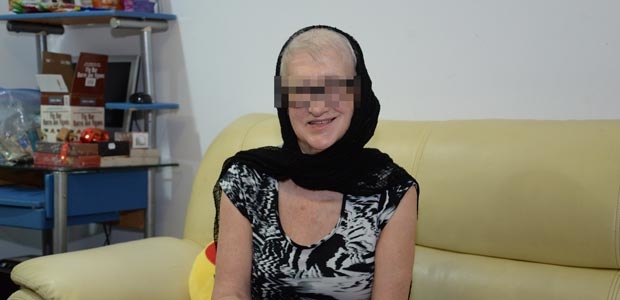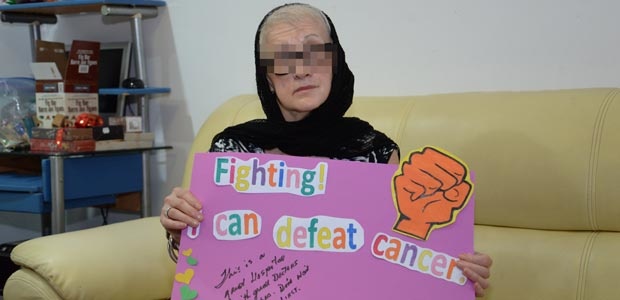Synovial Sarcoma is a malignant tumor which derives from joints, synovium and tendon sheath of synovial tissue. It can be mainly removed by surgery. The major clinical symptoms are local swelling, tumor, pain and activity limitation. For middle and advanced-stage patient, multiple metastases are common. When it occurs, surgical removal is in vain. What should the patient do? Director Ma Xiaoying from St. Stamford Modern Cancer Hospital Guangzhou recommended that the tumor can be controlled through effective minimally invasive treatment. In addition, the lifetime can be prolonged and life quality improved.
Vera was a synovial sarcoma middle and advanced stage patient from Canada. Though she got the tumor removed by surgery at local hospital, Little therapeutic effect caused recurrence , which made the condition being out of reach for doctors. It was her responsibility as a mother and desire of survival that prevented her from giving up. Instead, she chose to undergo minimally invasive treatment, which brought her back to life in St. Stamford Modern Cancer Hospital Guangzhou.
Tumor grow over and over again though many times of surgery were performed
She is 70 years old now and there’s a tumor occurred on her left neck when she was 40. She didn’t pay attention to the tumor due to being engaged in work and home. 12 years later, the tumor enlarged and was diagnosed as left neck synovial sarcoma stage II. On the doctors’ advice, she underwent surgery. Removal of early malignant tumor often goes with chemotherapy and radiation therapy, which jointly avoid recurrence and metastasis. However, chemotherapy and radiation therapy do severe harm to human body with side effects of nausea and vomiting.

Vera
Vera gave up Chemoradiotherapy, while she suffered from 4 recurrences and 3 surgical removals in later 18 years. Until the 4th surgery, as big as a cabbage, the tumor broke and bled. She even fainted once due to hypotension caused by excessive loss of blood. I passed out and hit the ground, my forehead broke and received 12 stitches. However, when I woke up, finding out there was blood all over the floor and it looked like a crime scene”, according to her description.
Vera had 4 children. Her husband unfortunately died of colon cancer in her 50. Facing the cruel reality, she had no choice but to figure out the solution to solve the plight ahead, rather than immersed in sorrow. Afterwards, she got to know St. Stamford Modern Cancer Hospital Guangzhou online and the consultant told her: “we provide 18 methods of minimally invasive treatment for cancer.”
On arriving St. Stamford Modern Cancer Hospital Guangzhou, Vera was in rather weak condition. On the one hand, the tumor has enlarged to 12cm*10cm, accompanying with bleeding. On the other hand, she also had severe symptoms of low protein, anemia and stumbling. Multidisplinary Team (MDT) from MGHG immediately held a meeting based on Vera’s case. Back then she has progressed to middle and advanced stage with lymph node metastasis. There was no operation indication, being insensitive to chemoradiotherapy and rupture hemorrhage would occur at any time, which was life-threatening.

Interventional therapy is a minimally invasive therapy performed under the guidance of medical imaging equipment. Implant a special tube into the body through which injects strong anticancer drugs into the tumor location and cut off the tumor’s blood supply and cause cancer cells death. It is known that embolism with anticancer drugs has sustained effect on the tumor, which is paramount in cancer treatment.
According to the Director Ma Xiaoying, after the interventional therapy, the symptom of bleeding promptly disappeared, the tumor greatly shrunk, Index of hemoglobin and protein also backed to normal. Currently, Vera took care of herself and lived as a normal person, which means she could honor her responsibility as a mother.
Sarcoma, a rare malignant tumor, occurs three cases among 100,000. Incidence rate of synovial sarcoma is even less, only accounting for 10% in soft tissue sarcoma. Due to implicit early symptoms, Synovial sarcoma is often misdiagnosed as injure or arthritis with symptoms such as joint pain and swelling, especially for young people featuring high incidence rate. Mostly, the symptoms was mistaken as recent injure from exercise or ostealgia during anagen. Therefore people resorted to doctor until severe pain occurs due to rapid development of the tumor, which indicates middle and advance stage. Director Ma also recommended that if abnormal lump detected in organs such as joints, legs and neck, one should undergo screening and diagnosis in professional medical institution. Once being diagnosed, promptly take treatment in experienced medical center.
“Early radical surgery can reduce the tumor recurrence. While middle and advanced stage patients should consider comprehensive treatment such as minimally invasive treatment, targeted therapy, chemotherapy and radiation therapy," Ma said.
*Surgery, in addition to the appropriate chemotherapy and radiotherapy, are effective in treating early cancer, but certain patients in late stage of cancer may not be tolerate surgery well as they can be relatively weak. A combination of carefully planned minimally invasive therapy, chemotherapy or radiotherapy can effectively reduce the side effects and discomfort of treatment and may help patient get better efficacy.













 viber
viber